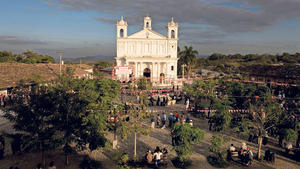
 El Salvador: what tourists are missing
El Salvador: what tourists are missing
February 7, 2014 6:25 pm
By Chris Moss
©Philip Scalia/Alamy
Santa Lucía Church in the centre of Suchitoto
I
was short on time. We had the wrong kind of car. The keys to the
four-wheel drive were misplaced. I was hungry, thirsty and hot. The
guide had forgotten his torch. And it was getting late.
The climax of my five-day trip through El Salvador – a visit to the El Imposible National Park – was beginning to look like an existential pun. Benjamín Rivera, 40, the guide-cum-driver, was desperate for me to see the bird life and hike through the tropical forest – one of the few areas of true wilderness left in this densely populated, intensively farmed country.
When we finally had all the tools for the trip, Rivera asked me if I wanted the scenic route or the fast road.
“The most direct route,” I said.
He
took the scenic route. Guides always know best, or so he had reminded
me during our road trip through Central America’s smallest country. It
had started 320km away in the east, with a motorboat ride from Nicaragua
to the port of La Unión.
After welcoming us on board, Mario
Meléndez, 37, our captain, had run through the wildlife we passengers –
myself and three Swiss tourists – might see: manta rays, ospreys,
frigatebirds, dolphins. He showed us pictures of tree species and
mangroves, a diagram of an oyster-farming project we would pass, and
named the volcanoes we could see on every horizon.
Many people were not as lucky as Meléndez during the conflict, in which an estimated 75,000 lost their lives. The Oriente region’s hilltop town of Perquín, where I spent my first night, was a centre of resistance. Over coffee I spoke to Serafin Gómez Lima, 43, a former child soldier who now spearheads tourism projects.
“After the peace accord of 1992, we realised the war story could appeal to visitors,” he said. “We organised a festival for Salvadoreans and then opened the Museo de la Revolución.”
The museum is a rich if roughly assembled collection of war memorabilia, weapons and photographs of heroic-looking guerrillas. Stylish agitprop posters from the 1980s are a reminder of the support that the rebel movement received from leftwing populations in Europe and the US.
I got my fill of dark tourism in Perquín and its environs – Rivera and Gómez Lima insisted on taking me to the interment of some victims’ remains in nearby El Mozote – but the experience was engaging. Being a traveller in a recent war zone isn’t voyeurism but, for Salvadoreans, an act of witness.
Suchitoto is El Salvador’s poster city. It is cobbled, quaint and at weekends fills with visitors from the capital 50km away. The word “colonial” is thrown around loosely in Latin America but some of the buildings here are the real thing – including the former mansion where I stayed, Los Almendros de San Lorenzo, built in 1805 for Spanish landowners.
Opened in 2005 after 17 months of restoration work, the hotel’s six rooms (and separate honeymoon villa), pool, restaurant and palm-tree-filled patio cover a city block. Owned by Pascal Lebailly, 53, a French former fashion events organiser, and his Salvadorean partner Joaquín Rodezno, 60 – who used to be the country’s ambassador to Paris, Rome and Brussels – it is decorated with Salvadorean artworks and high-value craft pieces. The men are now ambassadors for a country they regard as safe, unspoilt by tourism and misrepresented by the media.
“A lot of people are interested in El Salvador now that Panama and Costa Rica have become expensive, especially for visiting Americans,” said Lebailly. “Here they find everything they want at affordable rates.
“It’s time to correct the country’s image. Local media only report crime statistics and violence and that’s what foreign media pick up. But the data are never analysed. None of the crimes affect tourists and none of the reports reflect the friendliness of the people.”
Over the past nine years, Lebailly and Rodezno have seen a “slow but steady” increase in visitors, including independent travellers from the US, Canada, Colombia and Brazil and small tour groups from western Europe. Russians and Polish travellers are also beginning to arrive.
“As the country opens up to travellers, service gets better,” said Lebailly. “But there’s no mass-market tourism here.”
